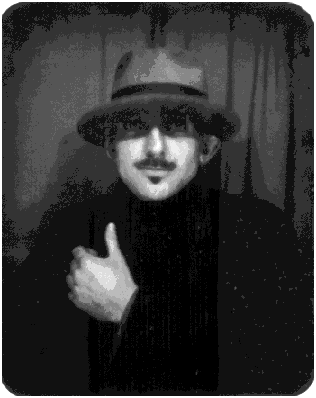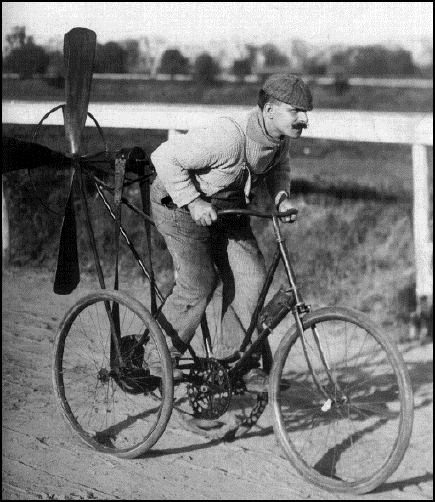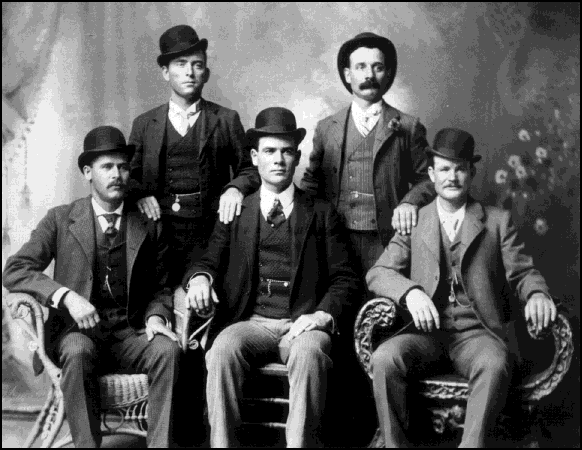Photography and
The Smithsonian
Merry A. Foresta,
Editor
(The Smithsonian Institution)

At First Sight:
Photography and
The Smithsonian
Merry A. Foresta,
Editor
(The Smithsonian Institution)Frog blood (1844), the moon (1863), the Pyramids of "El-Geezeh" (1858). Samurai in Japan (1863), Holy Trinity Church, London (1845), and a very sullen Emperor Meiji of Japan (1873).A not-very-sullen Genius "Engaged in Multiple Tasks" (1940), seven very dirty coal miners (1924), and a not smiling Thomas Smillie (1900). Six nervous newsboys in New York (1905), one giant waterwheel (1890), one bullet and three balloons in various stages of pop (1964).Fifteen merry thus probably innocent and not very blackfooted Blackfoots with tipi, Montana, 1890. Party-going rafters complete with banjo, ukulele and fishing pole (1910). And a hundred or so probably unwashed Union Army soldiers at Petersburg, Virginia (1864).

A very earnest looking fellow on bicycle with fan (or propeller, or tailwind) (1905). A very ugly Alopias vulpinus (Thintail Thresher) (1871), a very amorphous Himantura signifier (Stingray) 2002, and a very bony Pristigenys alta (Short big eye) (2002).A charming she-looks-
just-like- my-older- sister shot of Amelia Earhart with a lovely white Cord Phaeton (1936). A smirking Charles Lindbergh with Plane (1927), and Duke Ellington filled with fun and song (1960). § § § The photographs go all the way back to the very earliest printing experiments of 1840 or thereabouts, and include an 1846 shot of a model of the castle of the Institution. The early present is represented by some rather garish shots of Lucille Ball complete with pink veil, red lips, blonde hair, blue eyes. There is a winsome shot of Ansel Adams taken in a photo booth in 1930 (A self-portrait of Ansel Adams made in a photo booth!)
There are eight bombardiers hoisting eight 100-pound bombs to keep fit "for instantaneous action," just in case we were called to war and they had to heave these things from their cockpits (1950). There's Butch Cassidy and the gang looking just like turn-of-the-century bankers --- well, they were bankers, in a way. [See Fig. 4 below].There's Marian Anderson singing, in Washington, D. C., in 1939. Since she was black, and this was the time of segregation, the Daughters of the American Revolution, in what must be one of the great Public Relations moves of all times, refused to let her sing at Constitution Hall. Harold Ickes invited her to sing at the Lincoln Memorial. 75,000 people attended. Millions more listened on radio. Whatever became of the DAR, anyway? If you go to www.dar.org and type in her name, this is what you get:
Q. Why was famous black contralto, Marian Anderson, not permitted to sing at Constitution Hall in 1939?
A. The incident in 1939 was one of the first milestones in the struggle for Civil Rights in America. Washington, D.C., was a segregated city at that time and Constitution Hall limited performances to white artists. As the country began to tear down the barriers of race-discrimination, DAR followed suit and changed its policy for the Hall. Miss Anderson sang at Constitution Hall six times after 1939 and launched her farewell tour from our stage.
See: it wasn't the fault of the Daughters. It was the fault of society at large, or Washington D.C.
§ § § There are some 300 pages consisting of 150 photographs or so, drawn from the 13,000,000 photographs stored hither-and-yon in the sixteen museums that encompass the Smithsonian Institution. You figure it out: how does one go through 13,000,000 photos to cull a mere 150 for reproduction?
One thought on how this sumptuous book might have been even more so: dump the narratives --- the ho-hum history of photography in the Introduction and four other squibs ("Democracy of Images," "A New World," "Seeing as Believing," "Proofs Positive"). Let the pictures speak for themselves. We don't need words to tell us how fine and fascinating and interesting it all was and is. Another 150 shots might well have helped, at least to put a dint in those millions and millions looming over us, right now, as we speak.

--- Lolita Lark
Buddha
Volume I:
Kapilavastu
Osamu Tezuka
(Vertical
NBN, Distributors)You've seen Jesus Comix and God Comix --- now we have Buddha Comix, from Vertical. There are eight projected volumes in all, beginning with this one and Volume Two, "The Four Encounters." All are drawn in classic Manga style, from the pen of Osamu Tezuka.This one begins in India, tells --- or shows --- how the rabbit ended up in the moon (making mushi), and has us journey with disciple Naradatta to find the "mysterious man."Meanwhile, Tatta, young juvenile delinquent and tamer of beasts, meets with the young Chapra, and as they speak ("That's so cool!" "You're the best, Tatta," "I'm really impressed ") takes us on various adventures: meeting but not being eaten by man-eating tigers, a time of the plagues of locusts, and threatened immolation --- at which point we meet up with Naradatta. It's all fairly classic: war, plunder, contests, and being sold into slavery.
Unless you are into pre-Buddhist history, it might be somewhat obscure, but the drawings are fun, the adventures classic, and the thought that someday (by this fall) there will be eight volumes in all might be irresistible to some of us who cannot lay down a comic book, no matter how well or poorly conceived.
We give this one three stars for an imaginative blend of young adventure, fun graphics, and the chance to learn something out of ancient Eastern fables.
--- W. F. HalsteadInside the
Mind of God
Images and Words
Of Inner Space
Michael Reagan, Editor
(Templeton Foundation Press)Some of us are quite fond of pretty pictures, especially those pictures that are spawned by reality. Editor Reagan has collected dozens of colorful shots of facets of humans, including neurons, nerve cells, crystals, cell bodies, embryos, DNA, virus, and agents. These are printed amidst Big Thoughts from the likes of Jonathan Miller ("Illness is not something a person has. It's another way of being") or Erwin Chargaff ("Science is wonderfully equipped to answer the question 'How?' but it gets terribly confused when you ask the question 'Why?'") or Paul Tillich ("Being religious means asking passionately the questions of the meaning of our existence and being willing to receive answers, even if the answers hurt") all interjected between bewauitiful shots of Mitosis, DNA Migration, Embroyos, Hodgkin's Disease cell lines (appears to be cornflakes with milk), Lyme Disease Bacteria (looks like Chinese take-out), Transmitting Neurons (map of the New York subway system), Embryonic Stem Cells (4th of July streamers), Lung Cancer (arbor of grapes).It's lovely stuff, even if all the microscopic particles have been gussied up to look pretty and interesting --- but it is, in truth, a study in non sequetors. James Joyce is quoted as saying "Mistakes are the portyals of discovery" which is mounted against a highly magnified shot of the anti-AIDS drug Videx. "You can never prove God, you can only find him..." by Kate Douglas Wiggin (of Rebecca of Sunnybrook Farm fame) hovers near a magnified spectrum photo of Amoxicillin, as is Chief Seattle's statement "There is no death. Only a change of Worlds." Galileo's "Philosophy itself cannot but benefit from our disputes, for if our conceptions prove true, new achievements will be made; if false, their refutation will further confirm the original doctrines" lies uneasily under a bunch of neuron cells, and across from a sector of gray matter in the brain. It must mean something, but then again, it may not. no matter --- we have always been fond of Profound Thoughts and coupled with pretty Profound Pictures, we have doubled our fun. However, we prefer the earilier book, also from Templeton, that presumes to show us The Hand of God, which not only consists of pretty thoughts ("Because a star explodes and a thousand worlds like ours die/we know this world is./That is the smile: that which might not be, is?") opposite a glorious fat purple double balloon which the caption tells us is the Star Eta Carinae blowing up at around a million miles an hour. Now that is going some.